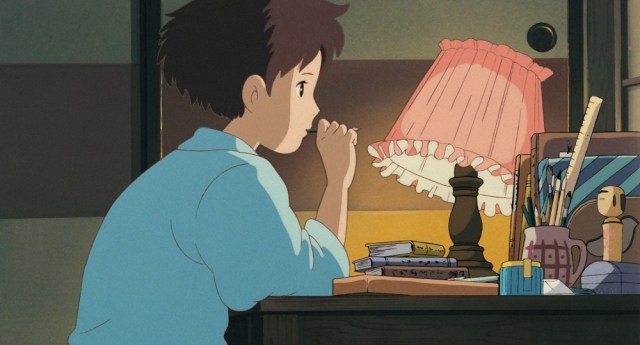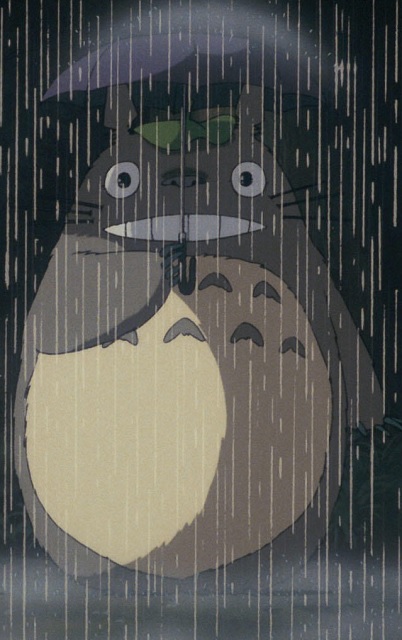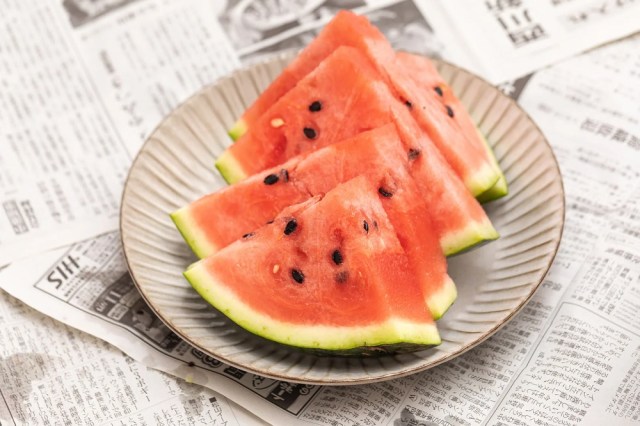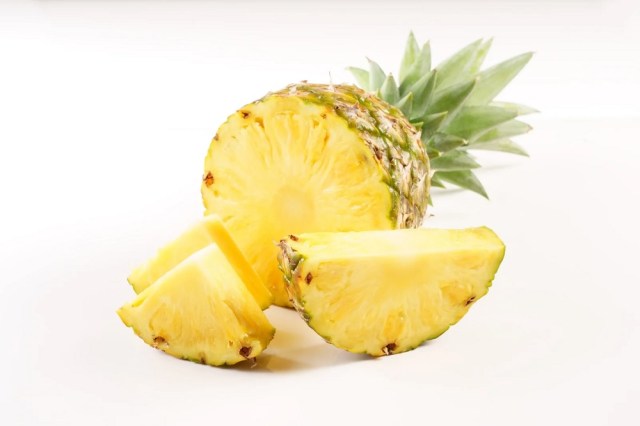
They do things a little differently at Studio Ghibli. Given the feast or famine realities of life in the anime industry, many production houses take on as many projects as they can, but part of the philosophy behind Ghibli’s founding was that if the staff felt like making something, they would, and if they didn’t, they wouldn’t. That’s not to say Ghibli’s animators don’t give maximum effort though, which the higher-ups recognize and reward with weekly massages on Saturdays.
Ghibli’s uniqueness isn’t limited to its artistic ideologies and rub-down policies, though. Its interview process for new animators is pretty unorthodox, too, with applicants being asked to complete such tasks as sharpening pencils and slicing up watermelons.
As part of his biannual interview series, media personality Hideyuki Nakamura recently spoke with Hiromasa Yonebayashi, the director of Studio Ghibli’s newest film, When Marnie Was There. The 41-year-old Yonebayashi, who made his directorial debut with 2010’s Arrietty, said that for as long as he can remember, he’s enjoyed drawing. Given his line of work, that’s not unusual, nor is the fact that he’s enjoyed reading comics since he was a young kid. What is surprising, though, are Yonebayashi’s specific manga preferences.
“I’ve always read shojo manga, even when I was growing up,” Yonebayashi recalls, referring to the subset of Japanese comics written for girls. “I didn’t read Fist of the North Star, but I read Tokimeki Tonight.”
In all fairness, Fist of the North Star’s martial arts-based people-exploding action and Tokimeki Tonight’s monster-based romance hijinks are both entertaining in their own ways.
“In shojo manga, there are many delicate, cute girls, and I tried to imitate that style of art in my drawings,” says Yonebayashi, who would often create his own manga which he would then show to his family and classmates. It wasn’t until he was in college, though, that he thought about pursuing a career in animation. “As a part-time job, I worked on an animated regional promotion commercial. It was the first time I saw my drawings move, and that was something I thought was really interesting when I saw the finished product.”
Although he submitted applications to numerous studios, Yonebayashi only heard back from Ghibli and one other outfit. He recalls that he initially had to submit two sample of his artwork, and Ghibli was impressed by them enough that he was called into the offices for a test. He did well enough that he was called in for a final interview, and like at many companies in Japan, there was more than one interviewer in the room with Yonebayashi. But rather than just multiple representatives from the HR department, Yonebayashi found himself sitting face to face with Hayao Miyazaki and Toshio Suzuki, the most successful director and producer in the history of anime, and two of Studio Ghilbi’s three founders.
▼ We’d like to believe there was a third, anonymous interviewer dressed as Totoro who spent the entire conversation standing silently in the corner of the room.
We’re not sure if it’s due to the many years that have since passed or the nervousness he possibly felt from having the two luminaries lobbing questions at him, but Yonebayashi says he can’t remember what either Miyazaki or Suzuki asked him. He does remember something else that happened during the hiring process, though.
“As part of the test, they gave me a pencil and told me to sharpen it. Later, someone came and collected the pencil and the shavings.”
Old school animation fans may be nodding their heads in approval, perceiving this as a sign of how Ghibli values hand-drawn art over computer-generated visual effects. The thing is, though, Ghibli doesn’t give the pencil test to all applicants. “They ask different people to do different things,” Yonebayashi reveals. “Sometimes they ask them to cut a watermelon, and a few people end up cutting it into discs.”
▼ This photo isn’t from a Ghibli test, but the result is the same.
Wait a second, watermelon discs? How’re you supposed to eat those? Only a crazy person would slice it like that, and actually, that’s the whole point of the test. “It’s kind of their way of checking, ‘Do you know how to apply common sense?’” Yonebayashi concludes.
▼ Much like how during my RocketNews24 interview my eventual boss gave me a glass of pineapple juice, and I impressed him by not spilling it all over my lap.
Weird as it may initially seem, the quirky check is very much in keeping with the attitudes Ghibli is known for. The studio’s films are loved not just for their technical merit, but for the human element contained in each frame of its best scenes, whether in a character’s subtle movements, the motivations driving the plot, or the natural deliveries from the vocal cast. In order to produce something like that, Ghibli needs people who can not only draw, but who can understand how the human mind works and faces a challenge, whether it’s something as simple as sharpening a pencil or as epic as looking for a castle in the sky.
Source: Katsumoku, Livedoor News
Top image: Studio Ghibli
Insert images: Studio Ghibli, Pakutaso (1, 2)




 Ghibli producer provokes backlash for comment regarding abilities of women to direct anime
Ghibli producer provokes backlash for comment regarding abilities of women to direct anime Miyazaki’s next project and reaction to latest Ghibli film revealed in interview with Toshio Suzuki
Miyazaki’s next project and reaction to latest Ghibli film revealed in interview with Toshio Suzuki American singer to perform theme song for newest Studio Ghibli film 【Video】
American singer to perform theme song for newest Studio Ghibli film 【Video】 New anime from director of When Marnie Was There is a Ghibli movie in everything but name【Video】
New anime from director of When Marnie Was There is a Ghibli movie in everything but name【Video】 Anime critic thinks Miyazaki may be unable to fill Ghibli talent void quickly enough for new film
Anime critic thinks Miyazaki may be unable to fill Ghibli talent void quickly enough for new film Cup Noodle tries an authentic Jiro-style ramen, but something’s not quite right
Cup Noodle tries an authentic Jiro-style ramen, but something’s not quite right We revisited Sweets Paradise after a decade to see if Japan’s dessert buffet still delivers
We revisited Sweets Paradise after a decade to see if Japan’s dessert buffet still delivers That time Seiji called JASRAC to ask why he didn’t get paid royalties for his song being on TV
That time Seiji called JASRAC to ask why he didn’t get paid royalties for his song being on TV 7-Eleven Japan’s ramen-cooking robot whipped us up a bowl of noodles【Taste test】
7-Eleven Japan’s ramen-cooking robot whipped us up a bowl of noodles【Taste test】 What did Shibuya really look like after the crowds on New Year’s Day?
What did Shibuya really look like after the crowds on New Year’s Day? Our team of five reporters try to turn themselves into Japanese heartthrob Kimutaku【Photos】
Our team of five reporters try to turn themselves into Japanese heartthrob Kimutaku【Photos】 Survey finds more than 70 percent of Japanese children have an online friend
Survey finds more than 70 percent of Japanese children have an online friend New Japanese menstrual product seeks to help women spot unidentified iron deficiencies
New Japanese menstrual product seeks to help women spot unidentified iron deficiencies Combining all of Nissin’s new Cup Noodle series into one powerful bowl of ramen
Combining all of Nissin’s new Cup Noodle series into one powerful bowl of ramen Japanese osechi New Year’s meal lucky bag gives us way more than we bargained for
Japanese osechi New Year’s meal lucky bag gives us way more than we bargained for Starbucks Japan ready to get Year of the Horse started with adorable drinkware and plushies【Pics】
Starbucks Japan ready to get Year of the Horse started with adorable drinkware and plushies【Pics】 7 great places to see Mt. Fuji from without having to climb it
7 great places to see Mt. Fuji from without having to climb it Cyberpunk anime meets traditional culture in Ghost in the Shell gold leaf Japanese changing screens
Cyberpunk anime meets traditional culture in Ghost in the Shell gold leaf Japanese changing screens Hayao Miyazaki says Happy New Year to Studio Ghibli fans with new art for Year of the Horse
Hayao Miyazaki says Happy New Year to Studio Ghibli fans with new art for Year of the Horse Hello Kitty Choco Egg figures are an adorable trip through three periods of Japanese pop culture【Pics】
Hello Kitty Choco Egg figures are an adorable trip through three periods of Japanese pop culture【Pics】 We found possibly the quietest Japanese-style hotel in Tokyo’s bustling Shinjuku district
We found possibly the quietest Japanese-style hotel in Tokyo’s bustling Shinjuku district Sumo Sanrio! Hello Kitty and pals team up with Japan Sumo Association for new merch【Pics】
Sumo Sanrio! Hello Kitty and pals team up with Japan Sumo Association for new merch【Pics】 Japan’s oldest largetooth sawfish in captivity back on display in Mie Prefecture
Japan’s oldest largetooth sawfish in captivity back on display in Mie Prefecture More Than a Capsule Stay: Why Solo Travelers Choose “global cabin Yokohama Chinatown”
More Than a Capsule Stay: Why Solo Travelers Choose “global cabin Yokohama Chinatown” 7-Eleven Japan starts new temporary luggage storage service in over 300 branches
7-Eleven Japan starts new temporary luggage storage service in over 300 branches Disillusionment at Tsukiji’s tourist-target prices led us to a great ramen restaurant in Tokyo
Disillusionment at Tsukiji’s tourist-target prices led us to a great ramen restaurant in Tokyo Starbucks teams up with 166-year-old Kyoto doll maker for Year of the Horse decorations【Photos】
Starbucks teams up with 166-year-old Kyoto doll maker for Year of the Horse decorations【Photos】 Tokyo considering law requiring more trash cans following litter increase in heavily touristed area
Tokyo considering law requiring more trash cans following litter increase in heavily touristed area Tokyo’s Tsukiji sushi neighborhood asks tour groups to stay away for the rest of the month
Tokyo’s Tsukiji sushi neighborhood asks tour groups to stay away for the rest of the month Tokyo event lets you travel back in time, for free, to celebrate 100 years since Showa era start
Tokyo event lets you travel back in time, for free, to celebrate 100 years since Showa era start Sanrio theme park in Japan announces plans to expand into a Sanrio resort
Sanrio theme park in Japan announces plans to expand into a Sanrio resort Japan may add Japanese language proficiency, lifestyle classes to permanent foreign resident requirements
Japan may add Japanese language proficiency, lifestyle classes to permanent foreign resident requirements Stamina-destroying “Paralysis Noodles” are Tokyo’s newest over-the-top ramen innovation
Stamina-destroying “Paralysis Noodles” are Tokyo’s newest over-the-top ramen innovation Survey asks foreign tourists what bothered them in Japan, more than half gave same answer
Survey asks foreign tourists what bothered them in Japan, more than half gave same answer Japan’s human washing machines will go on sale to general public, demos to be held in Tokyo
Japan’s human washing machines will go on sale to general public, demos to be held in Tokyo Japan’s deadliest food claims more victims, but why do people keep eating it for New Year’s?
Japan’s deadliest food claims more victims, but why do people keep eating it for New Year’s? We deeply regret going into this tunnel on our walk in the mountains of Japan
We deeply regret going into this tunnel on our walk in the mountains of Japan Studio Ghibli releases Kodama forest spirits from Princess Mononoke to light up your home
Studio Ghibli releases Kodama forest spirits from Princess Mononoke to light up your home Major Japanese hotel chain says reservations via overseas booking sites may not be valid
Major Japanese hotel chain says reservations via overseas booking sites may not be valid Put sesame oil in your coffee? Japanese maker says it’s the best way to start your day【Taste test】
Put sesame oil in your coffee? Japanese maker says it’s the best way to start your day【Taste test】 No more using real katana for tourism activities, Japan’s National Police Agency says
No more using real katana for tourism activities, Japan’s National Police Agency says Starbucks Japan reveals new sakura drinkware collection, inspired by evening cherry blossoms
Starbucks Japan reveals new sakura drinkware collection, inspired by evening cherry blossoms Updated cherry blossom forecast shows extra-long sakura season for Japan this year
Updated cherry blossom forecast shows extra-long sakura season for Japan this year Studio Ghibli animator reveals the secret food eaten by Chihiro’s parents in Spirited Away
Studio Ghibli animator reveals the secret food eaten by Chihiro’s parents in Spirited Away Hayao Miyazaki turns down offer to watch new anime film from former Studio Ghibli director
Hayao Miyazaki turns down offer to watch new anime film from former Studio Ghibli director Hayao Miyazaki spends retirement from anime by…spending every day at his animation studio
Hayao Miyazaki spends retirement from anime by…spending every day at his animation studio Ghibli top dog calls Evangelion director “driving force of anime,” raises hopes for more Nausicaa
Ghibli top dog calls Evangelion director “driving force of anime,” raises hopes for more Nausicaa Studio Ghibli announces new anime short in production, now recruiting staff to make it
Studio Ghibli announces new anime short in production, now recruiting staff to make it Studio Ghibli’s When Marnie Was There nominated for Academy Award
Studio Ghibli’s When Marnie Was There nominated for Academy Award Studio Ghibli is not Studio Goro – Hayao Miyazaki’s son denies being his father’s successor
Studio Ghibli is not Studio Goro – Hayao Miyazaki’s son denies being his father’s successor New Studio Ghibli mechanical pencils make writing and drawing a dream
New Studio Ghibli mechanical pencils make writing and drawing a dream Ghibli co-founder Toshio Suzuki retires as producer
Ghibli co-founder Toshio Suzuki retires as producer It’s good to have problems, Hayao Miyazaki tells Studio Ghibli staff
It’s good to have problems, Hayao Miyazaki tells Studio Ghibli staff Hayao Miyazaki working on new project, says “I’m going to continue making anime until I die”
Hayao Miyazaki working on new project, says “I’m going to continue making anime until I die” Ghibli school supplies will get you ready to go back to school in the spring, or your heart【Pics】
Ghibli school supplies will get you ready to go back to school in the spring, or your heart【Pics】 Beautiful full reprints of every past Studio Ghibli anime movie program can be ordered online
Beautiful full reprints of every past Studio Ghibli anime movie program can be ordered online Poster for Ghibli’s new movie under fire … from the big guru himself!
Poster for Ghibli’s new movie under fire … from the big guru himself! New Studio Ghibli anime coming this winter is first CG feature planned by Hayao Miyazaki
New Studio Ghibli anime coming this winter is first CG feature planned by Hayao Miyazaki
Leave a Reply